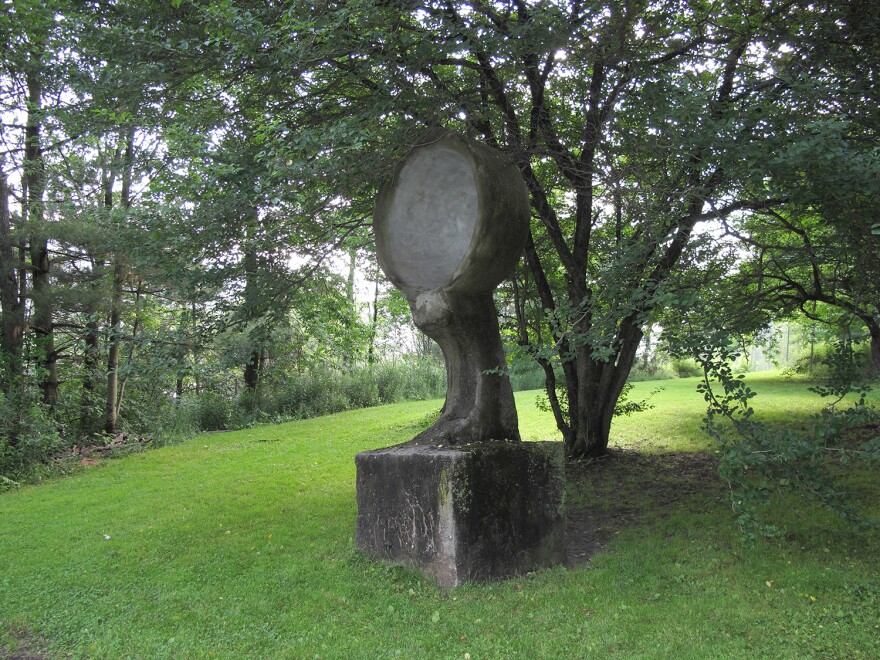A while back, Brave Little State got a question from Will Taylor, of Colchester, that we just couldn’t resist: “What is that bizarre thing at the Waterbury rest area?”
Will said “the thing” is fenced off now, but you used to be able to walk this path right up to it.
“There’s this little hill – you walk up the hill, and there’s this weird cement thing,” Will said. “It’s like on a big pedestal, and it’s basically like a giant cement bowl.”
Intrigued? So were we.
“I mean, it looks like it was a part of, like, industry, or something,” Will said. “There’s no sign, and I don’t know what it is, and I want to know what it is.”
Challenge accepted. Obviously, we had to go on a quest for the thing.
Brave Little State is VPR's new people-powered podcast. Listen to the inaugural episode here.
But – much to this reporter’s dismay – the thing proved impossible to locate.
It was not at the southbound rest area. It was not at the northbound rest area. Repeated inspections of said rest areas – a serious hunt for any clue that would indicate the location or the nature of the thing – yielded nothing. Inquiries at two Waterbury gas stations, as well as the town’s park and ride, were in vain.
Nobody had even heard of the thing.
It turns out that the difficulty of locating the thing – the object of Will Taylor's curiosity – was a big part of the story of the thing. And there are other things, all over the state. And they’re pieces of art.
According to Jack Zeilenga, the assistant state curator of the State of Vermont, Will Taylor's preoccupation is one of 14 massive sculptures at highway rest areas running the entire length of the state.

“They’re strewn about our rest stops all up and down Interstate 89 and Interstate 91, between the Canadian border and the Massachusetts border,” Zeilenga says.
These sculptures were the brainchild of a University of Vermont art professor and sculptor named Paul Aschenbach.
In 1969, Aschenbach convened Vermont’s first International Sculpture Symposium, and artists came from all over the world – Austria, Germany, Yugoslavia, Japan – to create monumental works of art, from marble that had been donated by the Vermont Marble Company.
Aschenbach convened a second symposium in 1971 – this time, artists worked with concrete courtesy of S.G. Griswold.
“There was a big push in the 1960s, certainly in Europe, to try to have this idea of fostering peace through art and public art,” Zeilenga says.
Aschenbach was a big subscriber to this philosophy – and Vermont’s interstates were a prime location for public art.

“At that time in the early history of our highway system, you know, people out on the road, [on] all these family road trips, would really be able to see and appreciate these at all the different rest areas,” says Zeilenga.
The piece at the Waterbury rest area is a sculpture by Aschenbach himself. It used to be visible from the road, and you could walk right up to it – this was when it caught the eye of Will Taylor.
According to Zeilenga, the concrete sculpture weighs about five tons. But today, it’s completely fenced off and hidden by trees.
Low visibility isn’t uncommon for the pieces in this collection, Zeilenga says. Sometimes you have to hunt around for them.
“They’re kind of a hidden gem around the state, in many ways, in this day and age,” he says.
But some of them are hiding in plain sight, including at Waterbury’s southbound rest area.

This collection of art occasionally draws attention from bloggers, photographers and members of the press. Chad Abramovich, the creator of the blog Obscure Vermont, describes the sculptures perfectly: “Monuments to enigmatic decrepitude.”
Some of these sculptures are in disrepair. There are no plaques or signs describing their history. And even if there were, 21st century drivers don’t exactly linger at rest stops.

But maybe we should. Next time you’re at a rest stop, get out of the car, walk around and see if you can catch a glimpse of a giant thing.
Brave Little State is made possible by the VPR Journalism Fund and Darn Tough Vermont.
Subscribe to Brave Little State for free, and never miss an episode:
Loading...






